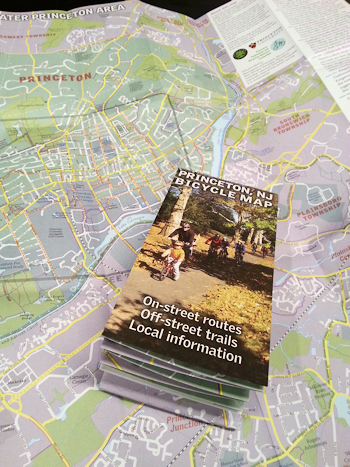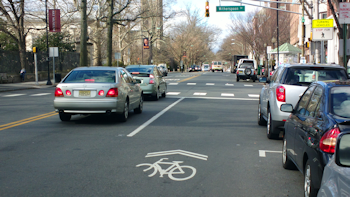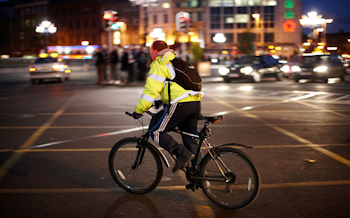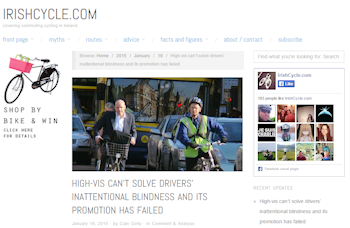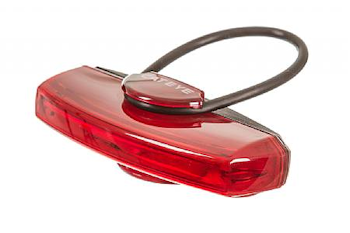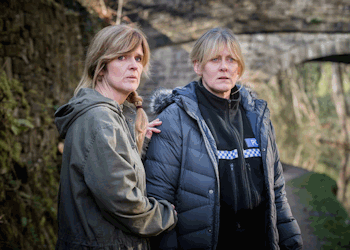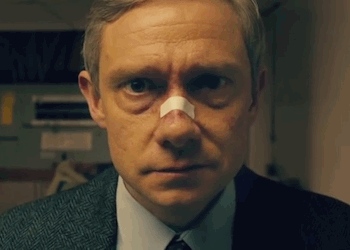
Further than it looks … 48km/30miles
I admit it.
I’m a cry-baby in the cold.
So it was with a fair amount of trepidation Steve and I set off for the big city. Of course it was good that it was heading to be the warmest day of the year as we boarded the Penn station bound train from Jersey Avenue.
Steve’s an old hand at this commuting with bicycle thing, so he knew exactly the right carriage to head for.
After grabbing a bagel in the station we headed off down 34th St looking for the West Side Greenway. The streets were pretty much a mess, even after the snow and ice had mostly cleared. Every gutter was strewn with filthy and sharp looking debris which encouraged us the use the Take The Lane approach.
The Greenway down to From Battery Park is pretty much finished with the odd detour onto the road. I suspect it won’t be long before there’s a straight run through. This time of year there are very few peds and even other cyclists to avoid. Just a couple of Freds heading north on their Colnagos and tri-bikes. This time they were generally on the right side of the track.
From Battery Park we went on pedalling up the East Side Greenway towards the Manhattan Bridge. The Brooklyn Bridge was already fairly congested with walkers.
The route then winds its way under the deck of the FDR Drive, so it’s pretty much a heavy urban environment but with a nice view over the East River and plenty of seniors practising tai chi and plenty of joggers doing what they do best – jogging down the middle of the bike lane with their earbuds on, oblivious to bells and shouts from cyclists, or anyone else for that matter.
We took a brief stop at the South Street Seaport and contemplated whether the cities/ports emblazoned on the sterns of the ships and boats there meant they were built in those places or just registered there. Still wondering.
First crossing of the day was the Manhattan bridge. On the open road these monsters would be a significant climb, albeit with a fairly gentle gradient. So, having not ridden a bike for months the old legs did creak a little, but there is always the reward of coasting down the other side. And you can be smug in the belief that you earned it.
Speaking of which, coasting, that is, I’ve converted the wheels on Brian … errr … I mean the Brompton, to tubeless.
The stock rims were sealed with Gorilla Tape. You need a fairly thick tape to help stabilise the bead of the tyre, which is critical in a tubeless configuration. I mounted Schwalbe Marathon Plusses and spent a few minutes making sure the bead was well seated in the rim. The front tyre inflated without even the application of any sealant. The rear required a little encouragement to make the seal, but snapped in perfectly after a couple of minutes encouragement. The seal was finished off with Stan’s. The Schwalbes are a snug fit under the Brompton’s mudguards, but clearance is enough.
So everything is non-standard and not what it was designed for. But it does work. In the week before the ride the pressure in the tyres didn’t vary by 1psi, so the seal must be pretty good.
Anyway, apart from the enhanced feeling of flat protection these tyres and the tubeless system gives they also roll pretty well and it was noticeable on downhills that the bike rolled better, even gaining on Steve, so I’m going to assume that their rolling characteristics are good in this application.
I’ll go into this in a bit more detail when I’ve got a few more miles in.
From the bridge we headed north towards the Kent Avenue bike lanes. Naturally, it was time for some lunch and we headed into Grand Street looking for a pub. Unfortunately most seemed closed. Fortunately we had already just happened to have spent five minutes locking up our bikes outside a Spanish tapas bar. Check out Cadaqués. Now despite it being a Spanish tapas bar it’s actually French. But to cut a long story short, it’s highly recommended. They do a great lunch time deal too; 2x tapas, 1x wine or beer, $15.
Having solved the problems of the world, we headed a few more streets north to Rough Trade Records, a Brooklyn outpost of the London store. As well as a great selection of indie-centric vinyl it also has a performance space – with a mezzanine sponsored by The Guardian – and a Brompton Café.
Unfortunately, although the lights were on, there was no-one home at the Brompton Café. Disappointingly, nor were we, as Brompton riders, even acknowledged in the store. Not that I was expecting a welcoming committee. Nor did anyone in The Guardian room recognise me as a fifty year veteran reader. Really!
Despite that, if you’re into records and music, that sort of stuff, Rough Trade is well worth a detour, as they say.
Once again we continued north, crossing the Pulaski Bridge into Queens. There’s a great view of the LIRR yards from there if you’re a bit of a trainspotter (who isn’t?).
Now, there’s something I didn’t know. There is a bridge onto Roosevelt Island. A while ago, Mrs Bloke and I took the tram – which isn’t a tram, by-the-way – over and walked around and returned to Manhattan on the subway.
Towards the north of the island there is a bridge from Astoria. It even has a cycle lane. It’s true that the cycleway uses the same steel grid that the road uses, and it has to be said that Brian … errrm … the Brompton was a bit skittish on that surface. Of course there was also the sensation of looking down through the grid to the East River way below. Hmmm.
By the time we reached the northern tip of the island the temperature was 57F/14C, and it was really the best of days after the weather of the last month or two.
It was time to think about getting back to Manhattan, so we retraced our route back to the Williamsburg bridge ready to cross over to The Bowery.
Our destination was the Paulaner, a German micro-brewery with, it seems, its own branch of the FC Bayern-Munich supporters’ club. They were watching Chelsea v PSG and, for some reason, seemed delighted at Chelsea’s misfortunes. Don’t know why.
Of course, the bier was excellent. The sausage was pretty good too. But before we could have too much of a good thing it was time to think about heading back for the train.
This involved cutting across downtown, heading for Eighth Avenue and Penn station.
It has to be said, cycling up Eighth Avenue after dark is exhilarating. We had the benefit of very bright, flashy lights and due to the density of the traffic it was easy to keep up with, and even pass the taxis, buses, delivery bikes, and weave amongst the pedestrians on the way.
Okay, so there were a couple of dodgy right-hookers, but all was negotiated fairly safely with a bit of friendly New York repartee.
The NJT service outbound was packed to the gunnels. Standing room only, which was a bit heavy on tired legs but great for making friends.
45km isn’t really that far, but it was my first ride of the year. And urban riding is pretty much stop/start and pressing the pedals away from the traffic-lights every couple of minutes takes its toll after a few miles.
So. A great day. Thanks to Steve who boldly goes just about anywhere, and Frank who demonstrated that if you’re in a German bier hall with a German, somehow Bayern-Munich fans know you’re German without even opening your mouth.








